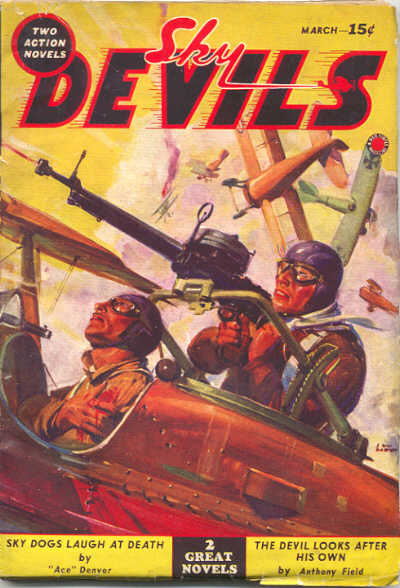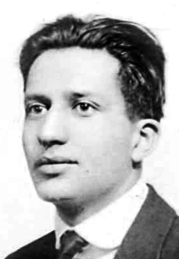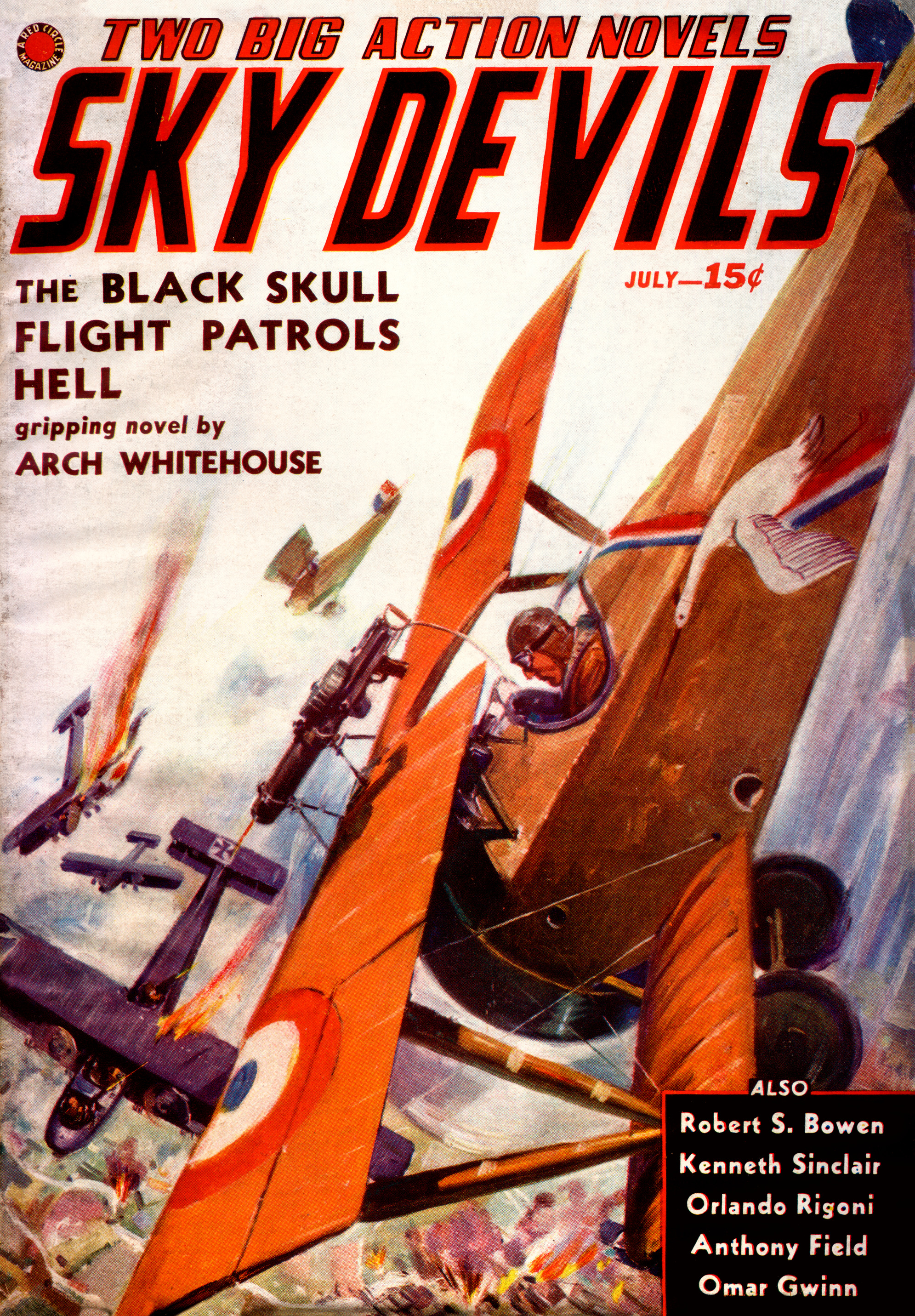THIS week we have  a story from the short-lived Sky Devils magazine by Anthony Field. Anthony Field was a pseudonym used by Anatole Feldman who specialized in gangland fiction—appearing primarily in Harold Hersey’s gang pulps, Gangster Stories, Racketeer Stories, and Gangland Stories. His best-known creation is Chicago gangster Big Nose Serrano. But he also wrote a number of aviation stories including four stories for Sky Devils featuring Quinn’s Black Sheep Squadron!
a story from the short-lived Sky Devils magazine by Anthony Field. Anthony Field was a pseudonym used by Anatole Feldman who specialized in gangland fiction—appearing primarily in Harold Hersey’s gang pulps, Gangster Stories, Racketeer Stories, and Gangland Stories. His best-known creation is Chicago gangster Big Nose Serrano. But he also wrote a number of aviation stories including four stories for Sky Devils featuring Quinn’s Black Sheep Squadron!
Quinn’s Black Sheep is another of those squadrons populated with other squadron’s troublemakers like Rossoff’s Hell-Cats or Keyhoe’s Jailbird Flight or any number of other examples. It seemed every author had a series with a black sheep squadron. But it’s odd to find a WWI series starting in 1938. By then, many of the air war stories were getting away from being set during The Great War as a possible second Great War loomed on the horizon. Additionally, many of the anthology air war titles no longer carried series characters—Dare-Devil Aces final series characters were Hogan’s Red Falcon and Smoke Wade, both of whom moved to G-8 and his Battle Aces in 1938.
Field wrote four stories with Quinn’s Black Sheep. “The Devil Looks After His Own” is the first of those four stories, appearing in the premiere issue of Sky Devils, March 1938.
Captain Jack Quinn is brought in for disciplinary action and manages to convince the General that he could solve a lot of his headaches by hand-picking the problem aces out of other squadrons and forming an essentially independent squadron to take on the Boche. Thus, Quinn’s flight was a crew of hard bitten aces who had been tempered—to a man—in the cauldron of war, having unflinchingly facing Death many times before.
Quinn assembled his squadron with Lieutenants Sam Steele and Jerry Twist from his own 40th pursuit squadron—Steele was thin, wiry, with eyes as hard as the name he bore while Twist was the opposite with laughing eyes and usual good-humored nature. To them he added: Sergeant Abe Solomon from the 64th—a short, swarthy man who weighed no more than a hundred and twenty pounds. His hands were small, his eyes twin coals in his narrow skull and his lips were bitter. He could fight and didn’t take any lip from other mugs just because they had shoulder bars. Major Nordstrom—heavy, thick set, brutal. Lieutenant Murphy, a mad, wild Irishman with a bull voice that put Quinn’s to shame. Captain Percy Dake—aka “Killer Drakę”—from the 12th, ex-ganster, ex-killer. Lieutenant Krueger, man of mystery who never talked and who walked silently like a cat. De la Roche, Captain in the French Army, an oily dandy who would have slit a throat without batting an eye, yet who had twenty planes to his credit. Von Goetz, German born, who had an undying hatred for the Prussian Military Machine. Lieutenant Janko, heavy, stolid, too lazy to move until he was behind the stick of a fighting plane. And lastly, Lieutenant Stephen Arden, a Britisher and a toff. He was reported to have broken a bottle of Scotch over a General’s head, his only regret being that the liquor had flowed away. Record, eighteen German planes, a half dozen machine gun slugs in his body and hard to handle when drunk.
Each man looked at Quinn with red murder in his heart—but Captain Quinn was the devil’s fair-haired boy.
about the author
(mostly stolen from his wikipedia entry)
 Anatole France Feldman (1901-1972) is primarily known as a pulp magazine writer from the late-’20s to the late-’30s. He specialized in gangland fiction, appearing primarily in Harold Hersey’s gang pulps, Gangster Stories, Racketeer Stories, and Gangland Stories. He also appeared in the rival magazines, Gun Molls and The Underworld.
Anatole France Feldman (1901-1972) is primarily known as a pulp magazine writer from the late-’20s to the late-’30s. He specialized in gangland fiction, appearing primarily in Harold Hersey’s gang pulps, Gangster Stories, Racketeer Stories, and Gangland Stories. He also appeared in the rival magazines, Gun Molls and The Underworld.
His best-known creation is Chicago gangster Big Nose Serrano. Big Nose began as a pastiche of the 1897 Edmond Rostand play, Cyrano de Bergerac. Serrano’s homely nose made him an unlikely romantic hero who thus composed love poetry for a better-looking associate. The plot and characters of the first Big Nose story, “Serrano of the Stockyards” (Gangster Stories, May 1930), roughly follow the corresponding elements in the play. Serrano’s overwhelming popularity with readers brought him back for further adventures. The stories are unrelentingly violent, and often intentionally amusing, providing a unique fictional take on Chicago’s gangland and the latter years of Prohibition. Feldman ended up publishing twelve of the Serrano adventures from 1930-35 in Gangster Stories, Greater Gangster Stories, and The Gang Magazine. As the series progressed, the Cyrano angle was dropped, and Serrano became an unlikely crusader against the social ills of the Depression, albeit applying the gangster’s methods of violence, kidnapping, and murder to the problems.
He stirred up a lot of controversy with the readers of Gangster Stories, with his novelette “Gangsters vs. Gobs,” a story that improbably pitted the underworld against the Navy. The controversy filled the letters column for several issues.
Feldman also wrote under a number of pennames, including Tony Fields, A.F. Fields, and similar derivations. In 1930-31, he co-edited the short-lived adventure pulp, Far East Adventure Stories. Writing under a Standard Magazines house name, he authored some of the lead novels in The Phantom Detective.
He was married to fellow pulp-writer Hedwig Langer, who published under the names H.C. Langer and Beech Allen. In the 1940s, they co-wrote plays. Feldman’s first performed play had been The Red Thirst in 1920.
In the 1940s, Feldman edited comic books for Hillman, Rocket Comics and Miracle Comics. Later that year he switched to editing true-crime and true confessions magazines for Hillman.
He was later employed at the Thomas Oil Co. in Saratoga, NY. He died in 1972 in Boonton, NJ. Hedwig had passed in 1969 after having been employed at Skidmore College.
 a story from the short-lived Sky Devils magazine by Anthony Field. Anthony Field was a pseudonym used by Anatole Feldman who specialized in gangland fiction—appearing primarily in Harold Hersey’s gang pulps, Gangster Stories, Racketeer Stories, and Gangland Stories. His best-known creation is Chicago gangster Big Nose Serrano. But he also wrote a number of aviation stories including four stories for Sky Devils featuring Quinn’s Black Sheep Squadron—this is the second of those four stories!
a story from the short-lived Sky Devils magazine by Anthony Field. Anthony Field was a pseudonym used by Anatole Feldman who specialized in gangland fiction—appearing primarily in Harold Hersey’s gang pulps, Gangster Stories, Racketeer Stories, and Gangland Stories. His best-known creation is Chicago gangster Big Nose Serrano. But he also wrote a number of aviation stories including four stories for Sky Devils featuring Quinn’s Black Sheep Squadron—this is the second of those four stories!




 a story from the short-lived Sky Devils magazine by Anthony Field. Anthony Field was a pseudonym used by Anatole Feldman who specialized in gangland fiction—appearing primarily in Harold Hersey’s gang pulps, Gangster Stories, Racketeer Stories, and Gangland Stories. His best-known creation is Chicago gangster Big Nose Serrano. But he also wrote a number of aviation stories including four stories for Sky Devils featuring Quinn’s Black Sheep Squadron!
a story from the short-lived Sky Devils magazine by Anthony Field. Anthony Field was a pseudonym used by Anatole Feldman who specialized in gangland fiction—appearing primarily in Harold Hersey’s gang pulps, Gangster Stories, Racketeer Stories, and Gangland Stories. His best-known creation is Chicago gangster Big Nose Serrano. But he also wrote a number of aviation stories including four stories for Sky Devils featuring Quinn’s Black Sheep Squadron! Anatole France Feldman (1901-1972) is primarily known as a pulp magazine writer from the late-’20s to the late-’30s. He specialized in gangland fiction, appearing primarily in Harold Hersey’s gang pulps, Gangster Stories, Racketeer Stories, and Gangland Stories. He also appeared in the rival magazines, Gun Molls and The Underworld.
Anatole France Feldman (1901-1972) is primarily known as a pulp magazine writer from the late-’20s to the late-’30s. He specialized in gangland fiction, appearing primarily in Harold Hersey’s gang pulps, Gangster Stories, Racketeer Stories, and Gangland Stories. He also appeared in the rival magazines, Gun Molls and The Underworld.